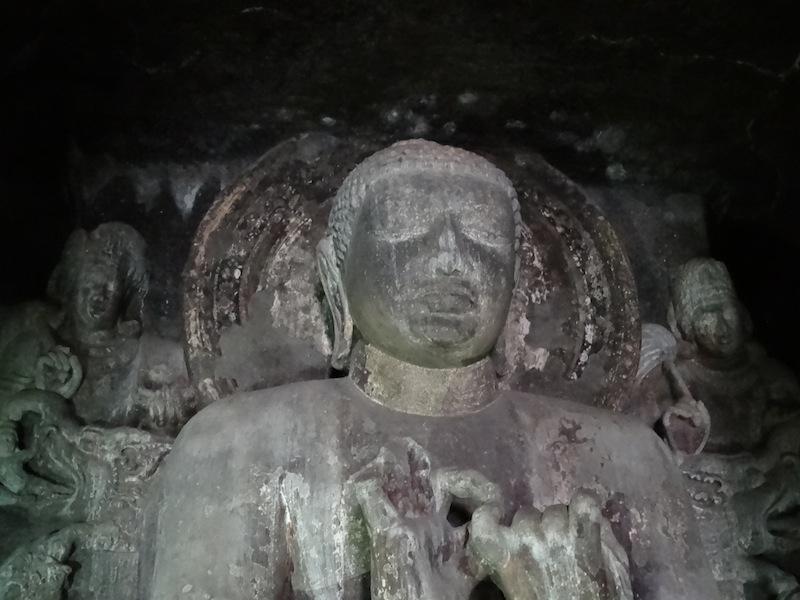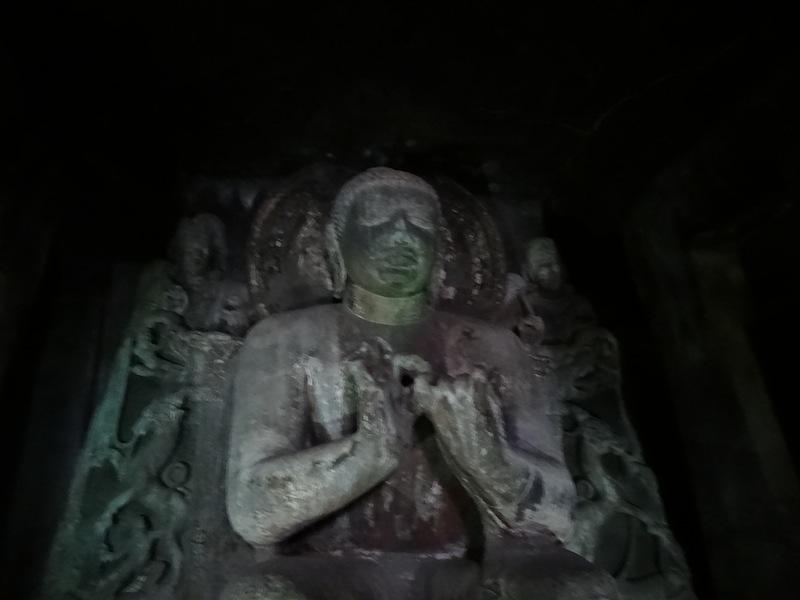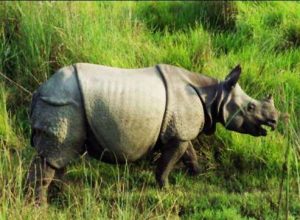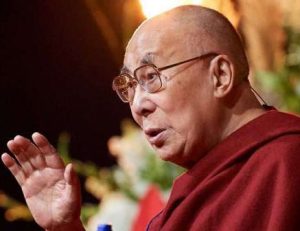Editor’s note: This article was first published in the now-retired Bodhi Journal, Issue 8, June 2008.
Introduction
In general when we talk about the Buddha, we tend to refer to the biographical account of the ??kyamuni who led a princely life, married a beautiful woman, and had a sweet little son. We are told that as time went by, the realities of life became apparent to him; sickness, old-age and death. After much contemplation, he renounced the worldly life and followed the simple life of an ascetic seeking an answer to the fundamental problem of life. He meditated day and night unceasingly, almost dying of starvation. We are told that He followed the Middle Path (majjhimapatipad?). One full moon day as the morning sun rose brightly, powerful flashes of truth filled his heart transforming Him into a fully enlightened being. He spent the rest of his life teaching for the welfare and happiness of all. This is the common portrait of Buddha.[1]
However, the story takes a deeper approach when it comes to Mah?y?na Buddhism. Buddha is seen more as an enlightened energy than just a historical figure. Buddha ??kyamuni was simply a manifestation of that energy which has always been there. Mah?y?nists believe that He was already enlightened but in order to demonstrate the Path, he created an example with his life so all could see and follow.[2]
Traces of Enlightenment Energy:
In the Yamakasutra, Venerable Yamaka tells ??riputra that Buddha is inconceivable, unfathomable, cannot be traced, and is not subject to limiting definitions. He is inexpressible and the source of all light.
Rain-fall benefits all crops, all trees, all bushes, all grasses – according to their requirements. Buddha is like the clouds (dharmamegha) and similar to the sun light, cast on valleys and hills – all surfaces of earth and landscapes according to their needs. This is the activity of the Buddha. He can appear in the form of a ??kyamuni Buddha, an Arhat, an ordinary being and in diverse forms. Unconceivable energy capable of helping countless beings is the Buddha. We cannot understand the unconceivable liberating method of the Buddha, we can only guess.
Candrak?rti [3] says:
“I am like the Bird, I have no more strength to fly, not that I cannot describe the qualities of the Buddha, but there are so much qualities that a Buddha possess.”
With the appearance of Lotus S?tra[4] , a mass notion of the Buddha is created, going beyond the conception of great meditators, great preachers, etc. He is all of this, but we can only see within the limits of our own vision. We cannot describe the qualities of the Buddha. We cannot understand the full picture. We can only begin to get a vague sense of the Buddha.
The use of Expedient Means
The life span of the Buddha is immeasurable and beyond all limits. It is like the sands of river Ganges, measured as grains and particles, they become immeasurable, countless, inconceivable, beyond all limits, incalculable and virtually eternal. In the light of this declaration and exposure, the life time of the Tath?gata is eternal. Tath?gata never enters extinction. We have reference to the historical events of the life and passing away of the Buddha ??kyamuni. The accounts of the Buddha’s birth, his renunciation, the years of striving, the attainment of enlightenment, the years of teaching and passing into Parinirv?na were simply an expedient means of teaching living beings, in order to demonstrate how Buddhahood is attained. Buddhahood was in fact attained by Buddha ??kyamuni eons earlier. Therefore this period was a reenactment of Buddha’s attainment of enlightenment. The teaching of the Buddha is accommodated according to the capacity of living beings. It is adjusted to the capacity, aptitude and inclination of living beings. All living beings have different dispositions as a result of their previous karma, impressions and the karmas they have accumulated over countless lives.
The teachings and the texts were adjusted and custom-designed for each particular disciple. The Buddha did not use a one size for all technique. The teachings and texts differ according to the ability of the disciples. But the purpose of all these teachings, without exception, is liberation. It does not matter how they differ in detail, whether they are teachings with regard to Arhat Path, or Bodhisattva Path, or whether the Buddha is retelling his own story, or retelling the stories of others Buddhas, other Bodhisattvas. All of these texts and teachings serve one purpose and that is for the purpose of enlightenment, liberation and crossing over. The Dharma is similar to that of a raft. It is for crossing over and not for holding on to. So whatever the Buddha may be, one should not hold on to this, because the Buddha is for the sole purpose of liberation. Once liberation is attained and the purpose is served, the teachings can be relinquished and discarded.
Our perception of the Buddha
How the Buddha is seen depends on the capacity of each individual. We may not recognize the Buddha even if we are face to face with him. We see him or we don’t, according to our own dispositions, karma and the purity of our faculties. In fact there was no starting point or extinction. The Buddha never entered Parinirv?na. Heappeared to enter Parinirv?na, and was always liable to appear. He is always present, always teaching the Dharma on the vulture peak in India where there is also a description of the Buddha ??kyamuni’s Pureland. When we look around us, we can hardly imagine this world as a Pureland, but in the text there is a description of Buddha ??kyamuni’s Pureland. It is the impurity of our perception that renders this world as an impure land where there are a lot of miseries, all kinds of suffering and deficiency. However, in actual fact, the Buddha is always dwelling in his Pureland, which is right here. This is also the case with the Pureland of the Sukh?vati, the Chinese school of Pureland School. It is quite clear that the Pureland is not somewhere else. That it is really in our mind. Similarly the Pureland of ??kyamuni is in our mind. So all we need to do is to purify our mind sufficiently and Buddha will be always present to us.
Now this may seem difficult. It is certainly difficult! Many of us have been practicing for many years. We still are not able to experience the Pureland of the Buddha ??kyamuni. We are still unable to experience a face to face encounter with the ever-present Buddha. But this does not mean that it does not exist. At this point, we can get some help from modern science. There is confirmation from contemporary science of some of our Buddhist beliefs and teachings of the Buddhist discourses. New physics informs us that there are hundred thousands of parallel universes. There are universes that are similar to ours, universes that are quite different or diverse and others that are totally from our universe. All these universes depend on alteration of mental perception, a slipcase in time and space. There are many descriptions and metaphors! Just as it is difficult to understand how Pureland can be all around us and how the Buddha ??kyamuni can be seated under Vulture Peak in India preaching the Dharma – this is difficult to understand. It is as difficult to understand how we could be just a hair width away from a parallel universe. People cannot imagine that a table does not exist! They find this very difficult to understand. So they ignore it. But quantum physics tells us of the parallel universe. Different worlds are existing side by side. The Lotus S?tra tells us that all the while, Buddha ??kyamuni is preaching the Dharma under the Vulture Peak, in the middle of his Pureland, what is this, other than a description of parallel universe? A universe that for the moment we cannot see, because of our limited means of observation and perception.
The Buddha’s passing away was simply a demonstration of expedient means to help us work for our own individual deliberation. If he was there, many would have taken advantage of him and not practice seriously, thinking Buddha would do everything for us. It is not difficult to understand this. Let’s say there is a famous person with much knowledge. We want to meet and follow his instructions. But we say, “today I have this work, so I cannot visit him. Maybe tomorrow I will do this.” Then when tomorrow comes we say, “oh I am tired!”Finally we become lazy and careless. For example people living near in Taj Mahal or the Borobodhur, may not visit these places often. It is only those who are living far away who take the great interest to visit and appreciate them. Buddha really did not pass away! He is always here. All teachings, all books, texts were composed by the disciples. Buddha teaches in different ways in order to enlighten different people. Dharma is just a raft!
Attitudes of Arhats
??riputra’s attainment of Buddhahood is also extremely important and interesting because it shows us the different attitudes of the different Arhats. In ??riputra’s case, for example, he is delighted, he is trilled, his mind dances with joy when he hears that he is going to become a Buddha. ??riputra used to feel, “why I am being left out? Why are these Bodhisattvas going to become Buddhas while I am left out, I can’t obtain Buddhahood,. Why am I being left out! I have always wanted to ask the Tath?gata about this. Now, when the Tath?gata tells me I also will become a Buddha, I am overjoyed, I am thrilled, I am happy; I finally am the real son of the Buddha, born from the Buddha’s mouth! I am not going to be just an Arhat, but I am going to become a Buddha.” ??riputra is delighted that he is going to attain the status of the Buddha, that he is going to be free from all residues and that he is going to have all the powers and attributes of the Buddha. Buddha not only predicts the Buddhahood of ??riputra, ??riputra reacts positively and is delighted by the announcement of the Buddha, but even he was subjected to doubt. At first he thinks, “can this really be true? May be this is the work of some devil!” But no, it wasn’t a devil, it was a skillful means of teaching. The Buddha first put him in the Path of Arhatship. He let him attain Arhatship, then when he was ready, he declared to him that his final destiny has been fulfilled; to be become Buddha. At this point, he predicted his Buddhahood and described to ??riputra, the nature of his Pureland. Because, when W?riputra becomes the Buddha, he is going to have a Pureland too, just as all Buddhas have a Pureland. Then in turn ??riputra predicts the Buddhahood of another disciple and how that disciple will become a Buddha and will establish his Pureland.
And so the process repeats itself. It goes on and on. But a lot of monks, Arhats, are confused. They do not understand the nature of this. The Buddha taught the Four Noble Truths, now he teaches another Dharma, a superior Dharma according to which all are going to become Buddhas. What is this? May be it is work of a devil! What kind of teaching is this? The audience becomes confused. The audience becomes upset. Some of the audience cannot accept this shift, this change. This is hardly surprising, because someone who has trained all their life according to their dispensation, and teaching, is suddenly told, “this isn’t the final dispensation! This isn’t the higher teaching!” It is difficult to accept, sometimes monks walk away. In M?lapariy?yasutta, the monks at the end of the Sutra, walked away grumbling among themselves, “what did the Buddha teach? What does this mean?” Usually the audience praises the Buddha, enchanted by the teaching of the Buddha. Sometimes when the Buddha teaches a difficult thing, the audience is puzzled, confused. Some are not ready to receive those higher teachings.
In the Prajñ?p?ramit?-s?tra, it is mentioned that the Buddha can be in deep meditation, at the same time, activate ??riputra’s curiosity to Avalokite’svara and simultaneously put a question to Maitreyaof how a son of a Buddha enters into the Prajñ?p?ramit?. Prajñ?p?ramit?is to transform wisdom into transcendental wisdom.
Teaching Methods
The Buddha has to use various means because enlightenment which is not an easy task. People have different capacities and abilities. Buddha has to divide special methods to help others. An understanding of the dharma does not come in an instant! The seeing of a wall is sudden, but walking up the wall is a gradual process.
Some of the more common general categories of teachings are the direct and indirect, conventional and ultimateteachings. Various Buddhists have their own explanations of what n?it?rtha and ney?rthais. Mah?y?na raises the bar very high on the ultimate truth. The Buddha, out of great compassion, devises skillful means to understand the state of mind of other beings. This is very important to Mah?y?na.
Examples
The Buddha’s dialogue with Sona (former musician):
When Sona was deciding to give up the life of a monk, Buddha told him not to push hard, or not to be lazy on the other hand, but always keep balance, thereby not harming the practice.
A horse trainer and the Buddha:
Once a horse trainer approached the Buddha and inquired how He trained His disciples. The Buddha put a counter question to him: “How do you train your horses?” He replied: “By gentle methods, harsh methods, by both, if it doesn’t kill them”.
Buddha replied, “In this same way I teach my disciples by gentle methods, telling them to practice and not self-indulge, and by both, by both means, by ignoring them.”
Buddha’s compassion towards Prince Nanada:
One day the Buddha went to the Palace. This was the day Nandawas supposed to be married to Sundar?. The Buddha knew that Nanda’s time had ripened for his enlightenment. He handed him the begging bowl without saying a word and walked towards the monastery. Nanda, out of respect, followed the Buddha to the monastery. When they reached the monastery, the Buddha asked him to become ordained as a monk. Nanda’s faith couldn’t refuse the Buddha. So he became a monk. But he was always thinking about his fiancé! One day, Buddha asked Nanda to accompany him to heaven. There they saw nymphs who were radiant and extraordinarily beautiful. Buddha asked: “Nanda, are these nymphs more beautiful than your fiancé?’. Nanda replied instantly: “yes, venerable sir, they are outstandingly beautiful. My fiancé is like the ugly she-monkey that we met on the way to heaven!” Buddha asked, “Do you desire them Nanda?” To which he responded, “I do very much, venerable sir!” Buddha said, “I promise them to you if you observe what I instruct you for sometime.” Nanda was so overjoyed that he began to practice whatever Buddha instructed from the moment they returned to the monastery! He began to practice but his intention was to have those beautiful nymphs! The other monk-friends teased him that he was practicing so hard merely to have those nymphs and not for enlightenment. This made Nanda think deeply. He became ashamed about intentions. He then directed his mind towards enlightenment and practiced day and night until he finally gained enlightenment. This was an experimental method used by the Buddha to liberate Nanda.
A wealthy man and his son:
A wealthy old man recognized his son one day and sent his guards to fetch him. But the son’s condition was very poor as he was not used to wealth. So the father employed him as a sweeper. As time passed by, the son gradually became more familiar with wealth and management. The father then employed him to look after his financial matters. Once the father was convinced that the son had gained enough maturity; he told him that he was his father. By that time the son was properly prepared to accept the fact and able to manage his father’s property. The father here is the Buddha and he used expedient means to help his son.
The transcendental dimension, which is beyond name and form, is called dharmak?ya. It is identical to all the Buddhas. What is different is their particular ages, time, place and heavenly appearance. Buddha is everywhere, but particular only to with those who have spiritual vision. When the Buddha was walking among the common, he was not seen or recognized. Buddha is still preaching in the Vulture Peak in India for those who can see with their meditative eyes. Anyone with these spiritual eyes can see Buddha everywhere.
Conclusion
How does Buddha appear to ordinary human beings like us? This answer was clearly stated just after his enlightenment when the Buddha met Up?ka (a wandering ascetic). Up?ka asked who he was, and who his teacher was, and so on. Buddha replied “I am none of them. I am the Tath?gata.” But Up?ka did not have the ability to understand. He just shook his head and left. Up?ka did not see the Buddha’s greatness because his ability was limited to a few concepts. Therefore he hardly understood Buddha. Most of us are also like Up?ka. Our understanding is so limited that we see things as existing or non-existing, beyond that we cannot see. The declaration that the Buddha does not exist nor non-exist does not apply to the Buddha, because he is a transcendental being. And since he is transcendental being, he appears as enlightenment energy that is untraceable and dynamic.
Bibliography:
1. Peter Della Santina: The Tree of Englightenment, Published by Singapore Buddhist Meditation Center.
2. Sangharakshita: Who is the Buddha?, Published by Windhorse Publications, Birmingham, 1994.
3. Peter Della Santina: The Buddhist Tradition of Mental Development, Manjushri Press, Boston 2002
4. Peter Della Santina: The Fundamentals of Buddhism, Chico Dharma Study Foundation, CA, 1997.
5. Sangharakshita: A Guide to the Buddhist Path, Published by Windhorse Publications, Birmingham, 1996.
6. Endo, Toshiichi: Buddha in Theravada Buddhism – A study on the Concept of Buddha in the P?li Commentaries, The Buddhist Cultural Centre, Dehiwala, 2002.
1. This is the Rupak?ya (physical form) of the Buddha which is divided into Sambhogak?ya (celestial form) andnirm?nak?ya (manifested form).
2. This is the Dharmak?ya (transcendental dimension) of the Buddha which is as a result of perfection of wisdom and compassion in innumerable life times and it works inconceivably and dynamically.
3. Candrak?rti, 7th century AD Indian scholar of Madhyamaka school of thought, was abbot of N?landa University and a disciple of N?garjuna and a commentator on his works. Candrak?rti was the most famous member of what the Tibetans came to call the Prasavgika school of Madhyamaka.
4. Lotus Sutra is one of the most important Mahayana sutras which talks about the various expedient means of the Buddha.
5. Maitreya is the Future Buddha.
6. Buddha has taught his dharma in n?it?rtha and also in ney?rtha. N?it?rtha means the meaning that is drawn out and ney?rtha means the meaning that is to be drawn out.
7. Nanda was the half brother of Siddhartha Gautama.














